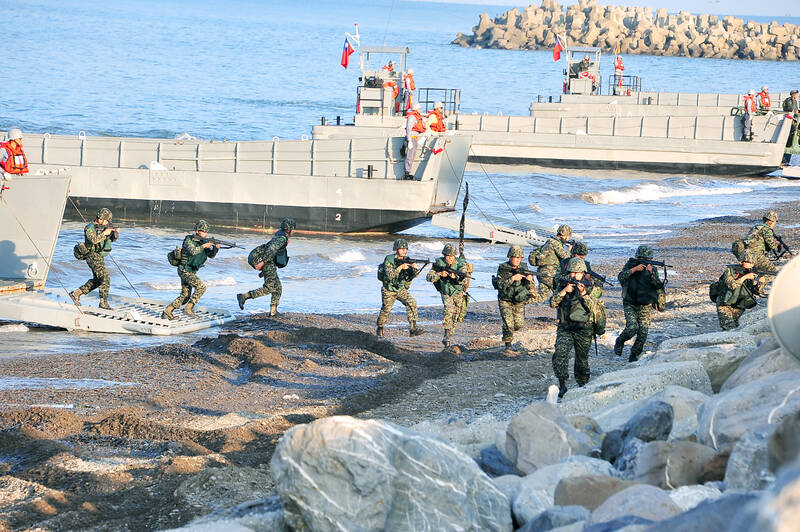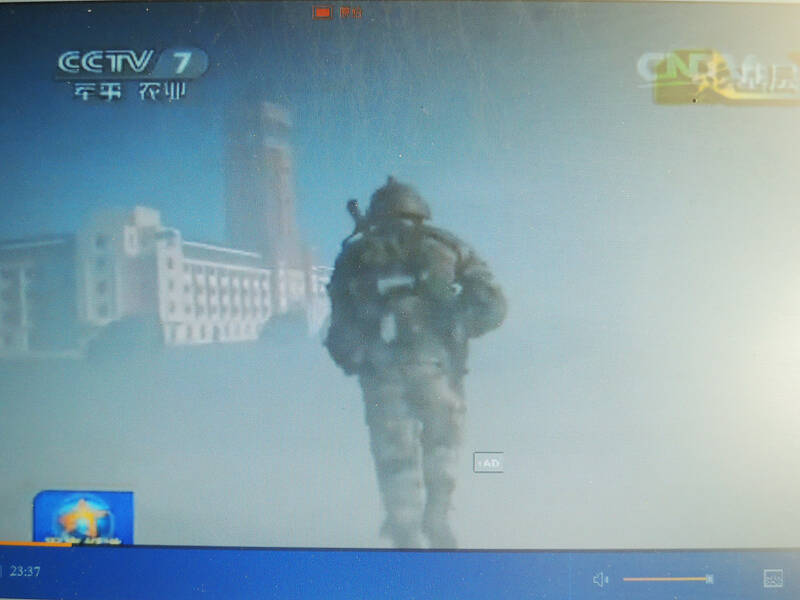“There were no decisive battles in World War II,” begins Philips Payson O’Brien’s amazing work How the War was Won: Air-Sea Power and Allied Victory in World War II.
O’Brien, who demonstrates that the war was won by the Western allies over the skies of Europe and the waters of the Atlantic in the “air-sea space” in which the great mass of German equipment was destroyed (in 1944 over half of German production went to single-engine fighters), dismisses most histories of the war as too “battle-centric.”
Chinese troops are frequently shown in People’s Liberation Army (PLA) videos storming beaches. For example, a video released on Oct. 10, 2021 (Double Ten National Day) shows beach landing exercises. Another from May of that year showed beach landings and the use of helicopter carriers. The PLA has also released videos of mock-ups of their troops assaulting Taipei and Taiwan’s Presidential Office at the Zhurihe (朱日和) training base in Inner Mongolia.

Photo: Taipei Times file
These videos are obvious propaganda (if the PLA reaches the point where it is assaulting the Presidential Office, the war is over), but their very obviousness could be a diversion: what if they are maskirovka, a form of military deception, meant to distort our perceptions of PLA intentions?
What if our conception of the invasion is too beach-centric?

Photo: Tsai Tsung-hsien, Taipei Times
BLANKET OF ILLUSION
The trope of storming the beaches Normandy style is a comforting blanket of illusion. Countless articles explain the problems the PLA will encounter. Not only will much preparation time be required, but the losses suffered by the thousands of Chinese troops presenting themselves as targets as they storm the beaches even as PRC war machines loiter in the water and air, easy pickings for defenders, seem daunting and discouraging.
Managing all that complexity, we are reassured, is something the PLA has never done before. Seems like they might not do it, right? What has China learned from the Ukraine War? Some lessons are already taking shape. One important one: the war must begin before anyone, including Beijing, is “ready.” Russia gave notice much too early that it was going to invade, enabling a comprehensive response. Beijing is going to seek strategic, not just tactical and operation surprise, to blunt the US and Japanese response.

Photo: Taipei Times file
That is why the cycling of PLA military planes and ships off the coast is so dangerous. They are not merely normalizing a Chinese presence, but setting up conditions under which they can start a war at any moment, or can gradually be increased until war has been stealthily prepared. Further, if some provocation or accident, like lasering a foreign military ship, sparks a local conflict, China will ready to expand it.
To put this in perspective, in just three days last week, the PLA cycled over 200 aircraft around Taiwan. People say we will detect the invasion by satellite. Perfectly true, we will become used to detecting it every day with the aircraft intrusions and PLA navy vessels near Taiwan.
PORT INVASION?
The Allies knew that the Normandy invasion force needed to grab a port to enable resupply and expansion of the initial invasion force. What if the PLA skips the beach part, and opens the invasion with an assault on a port?
Consider US General Douglas MacArthur’s landing at Incheon to seize the port there. MacArthur began mulling such a move shortly after the June 25, 1950 invasion of South Korea by the North. Serious planning began in August. The landings began on Sept. 16. Incheon was a nightmare, a tiny harbor with high sea walls and brutal tides, the highest tidal range in Asia, that would block reinforcements. A major misdirection campaign helped make the landing a total success.
I would argue that Incheon is a natural model for a PLA operation against Taiwan, but there are others. PLA military thinkers are certainly familiar with Soviet military writings, and they will have studied the Soviet amphibious landings in Korea and Japan in August 1945.
The Soviets did not hit Korean beaches, but instead seized three ports. Two of them, Rason and Sonbong, fell easily. The third operation, at Chongjin, met fierce Japanese counterattacks and was taken only when the Soviets drove off that most romantic of military weapons, a Japanese armored train that was defending the port, and when the Japanese laid down their arms on Aug. 15. At the same time, the Soviets were landing on Japan’s Sakhalin Island (it is now Russian). Again, they did not unload unto beaches, but directly seized two ports: Maoka (now Kholmsk) and Toro (now Shakhtyorsk). Resistance on Sakhalin was unexpectedly fierce, and few now remember that the fighting went into September, weeks after official surrender. The Japanese refusal to quit likely prevented a follow-on invasion of Hokkaido and a north-south division of Japan into competing Soviet and Allied zones.
In Taiwan, several west coast harbors would be ideal. Taichung harbor can handle large vessels, but artillery posted on Dadu Mountain (大肚山) could wreak havoc on the landings. However, Mailiao harbor (麥寮), the massive port constructed for the petrochemical complex in Yunlin County, can handle large oil tankers and has no natural defenses such as nearby hills.
POLITICAL ALTERNATIVE
The failure of the Russian decapitation strike on Kyiv in the first few days of the Ukraine War must have struck Chinese thinkers. Mailiao also offers a political alternative. First, troops based there would fan out into the pro-Taiwan heartland. Outside of the petrochemical complex, combat would wreck little of economic importance until the PLA reaches Changhua to the north and the Tainan Science Park to the south.
Second, as the PLA army advances northward, it would confront Taiwanese elites, who cluster in the most pro-China areas of Taiwan, with increasing pressure to surrender to at least preserve some of their wealth and the nation’s modern productive capacity, largely located in the north.
The Normandy trope also suggests the importance of weather in creating comfortable illusions. In his book The Chinese Invasion Threat, Ian Easton has a chapter on the weather problems confronting any invader. Annually, he observes, on average, “six typhoons will strike Taiwan, but some years see as many as nine typhoons.”
Anyone remember the last time a typhoon crossed the island of Taiwan or roared up the Taiwan Strait? As humans heat the earth, typhoons are staying away from Taiwan. The winter weather might be still be awful, but the summer is no longer the protection it once was. Luckily for Taiwan, recent Chinese scholarship (“Long-term variations of wind and wave conditions in the Taiwan Strait,” Regional Studies in Marine Science) shows that winds and waves in the strait are both increasing most strongly off the southwest of Taiwan.
The Normandy trope is wrong and misleading. Everything the PLA puts out showing beaches being stormed should be treated as misdirection.
At present, our beach defenses hide from the public. Perhaps a few weapons openly sited in ports, where tourists go in large numbers, might help shake public complacency.
Might even be useful too.
Notes from Central Taiwan is a column written by long-term resident Michael Turton, who provides incisive commentary informed by three decades of living in and writing about his adoptive country. The views expressed here are his own.

June 2 to June 8 Taiwan’s woodcutters believe that if they see even one speck of red in their cooked rice, no matter how small, an accident is going to happen. Peng Chin-tian (彭錦田) swears that this has proven to be true at every stop during his decades-long career in the logging industry. Along with mining, timber harvesting was once considered the most dangerous profession in Taiwan. Not only were mishaps common during all stages of processing, it was difficult to transport the injured to get medical treatment. Many died during the arduous journey. Peng recounts some of his accidents in

“Why does Taiwan identity decline?”a group of researchers lead by University of Nevada political scientist Austin Wang (王宏恩) asked in a recent paper. After all, it is not difficult to explain the rise in Taiwanese identity after the early 1990s. But no model predicted its decline during the 2016-2018 period, they say. After testing various alternative explanations, Wang et al argue that the fall-off in Taiwanese identity during that period is related to voter hedging based on the performance of the Democratic Progressive Party (DPP). Since the DPP is perceived as the guardian of Taiwan identity, when it performs well,

The Taiwan People’s Party (TPP) on May 18 held a rally in Taichung to mark the anniversary of President William Lai’s (賴清德) inauguration on May 20. The title of the rally could be loosely translated to “May 18 recall fraudulent goods” (518退貨ㄌㄨㄚˋ!). Unlike in English, where the terms are the same, “recall” (退貨) in this context refers to product recalls due to damaged, defective or fraudulent merchandise, not the political recalls (罷免) currently dominating the headlines. I attended the rally to determine if the impression was correct that the TPP under party Chairman Huang Kuo-Chang (黃國昌) had little of a

At Computex 2025, Nvidia CEO Jensen Huang (黃仁勳) urged the government to subsidize AI. “All schools in Taiwan must integrate AI into their curricula,” he declared. A few months earlier, he said, “If I were a student today, I’d immediately start using tools like ChatGPT, Gemini Pro and Grok to learn, write and accelerate my thinking.” Huang sees the AI-bullet train leaving the station. And as one of its drivers, he’s worried about youth not getting on board — bad for their careers, and bad for his workforce. As a semiconductor supply-chain powerhouse and AI hub wannabe, Taiwan is seeing